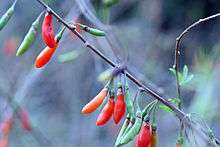Lycium chinense
Lycium chinense is one of two species of boxthorn shrub in the family Solanaceae. Along with Lycium barbarum, it produces the goji berry ("wolfberry"). Two varieties are recognized,[3] L. chinense var. chinense and L. chinense var. potaninii. It is also known as Chinese boxthorn, Chinese matrimony-vine, Chinese teaplant, Chinese wolfberry, wolfberry,[4] and Chinese desert-thorn.[5]
| Lycium chinense | |
|---|---|
 | |
| Lycium chinense fruits | |
| Scientific classification | |
| Kingdom: | Plantae |
| Clade: | Tracheophytes |
| Clade: | Angiosperms |
| Clade: | Eudicots |
| Clade: | Asterids |
| Order: | Solanales |
| Family: | Solanaceae |
| Genus: | Lycium |
| Species: | L. chinense |
| Binomial name | |
| Lycium chinense | |
| Synonyms[1][2] | |
| |
Description
Wolfberry species are deciduous woody shrubs, growing 1–3 metres (3 ft 3 in–9 ft 10 in) high, somewhat shorter than L. barbarum. The stems are highly branched. Branches are pale gray, slender, curved or pendulous, with thorns 0.5–2 centimetres (0.20–0.79 in) long.[3]
Leaves
Lycium chinense leaves form on the shoot either solitary in an alternating arrangement or in bundles of 2 to 4. Their shape may be ovate, rombic, lanceolate, or linear-lanceolate, usually 1.5–5 centimetres (0.59–1.97 in) long and 0.5–2.5 centimetres (0.20–0.98 in) wide (but up to 10 centimetres (3.9 in) long and 4 centimetres (1.6 in) wide in cultivated plants).[3]
Flowers
The flowers grow in groups of one to three in the leaf axils, with pedicels 1–2 centimetres (0.39–0.79 in) long.[3] The bell-shaped or tubular calyx (eventually ruptured by the growing berry) splits halfway into short, triangular, densely ciliate lobes. The corollae is a tube that splits into lavender or light purple petals, 9–14 mm (0.35–0.55 in) wide with five or six lobes longer than the tube, with short hairs at the edge. The stamens are structured with filaments longer than the anthers, slightly shorter or longer than the corolla, with a villous ring slightly above the base and the adjacent corolla tube.[3] The anthers are longitudinally dehiscent.
Fruit and seeds
Lycium chinense produces a bright orange-red berry, whose shape is ovoid or oblong, 7–15 millimetres (0.28–0.59 in) long and 5 to 8 mm wide (but up to 22 millimetres (0.87 in) long and 10 millimetres (0.39 in) wide in cultivation).[3] It contains compressed yellow seeds, from 2.5 to 3 mm wide, with a curved embryo; their number varies widely based on cultivar and fruit size, from 10 to 60. The berries ripen from July to October in the Northern Hemisphere.
Disease
It can be parasitized by the oomycete species Peronospora lycii.[6]
Use
The fruits may be infused with hot water to make goji tea. The plant has been used for centuries in traditional Chinese medicine for treating various disorders, although there is no high-quality clinical evidence that consuming it has any effect on health or disease.
Chemistry
The fruit composition is similar to that of L. barbarum. Polysaccharides, carotenoids and flavonoids are the typical constituents.[7] Rutin is the main flavonoid. The main carotenoid is zeaxanthin dipalmitate (49% of the carotenoid fraction). The fruit contains zeaxanthin, β-carotene, two cerebrosides, and three pyrrole derivatives.[7]
Dozens of secondary metabolites have been isolated and identified from the roots, root bark and leaves, including cyclic peptides, alkaloids, and flavonoids.[7] Citric acid is the major nonvolatile organic acid in the leaves followed by oxalic acid.[7]
Gallery
- Habitus
- Leaves and buds
- Leaves and flower
- Leaves and flower
_(1).jpg) Berries
Berries Dried berries
Dried berries
See also
- List of culinary fruits
- List of dried foods
- Sea buckthorn – somewhat resembles goji
References
- "The Plant List: Lycium chinense var. chinense".
- "The Plant List: Lycium chinense var. potaninii".
- "Flora of China treatment for L. chinense".
- "Lycium chinense". Germplasm Resources Information Network (GRIN). Agricultural Research Service (ARS), United States Department of Agriculture (USDA). Retrieved 10 January 2018.
- "Lycium chinense". Natural Resources Conservation Service PLANTS Database. USDA. Retrieved 24 June 2015.
- Constantinescu, O. (1991). "An annotated list of Peronospora names". Thunbergia. 15.
- Olivier Potterat (2010). "Goji (Lycium barbarum and L. chinense): Phytochemistry, pharmacology and safety in the perspective of traditional uses and recent popularity". Planta Medica. 76 (1): 7–19. doi:10.1055/s-0029-1186218. PMID 19844860.
Further reading
- Ai, Changshan (2002). Zhi Bu Liang Yi Hua Gou Qi (A Word About Lycium chinense, Effective for Therapy and Nutrition). Changchun, China: Jilin Ke Xue Ji Shu Chu Ban She. ISBN 7-5384-2402-4. ISBN 978-7-5384-2402-7.
External links
| Look up wolfberry or 枸杞子 in Wiktionary, the free dictionary. |
| Wikimedia Commons has media related to Lycium chinense. |